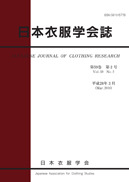Volume 52, Issue 2
Displaying 1-8 of 8 articles from this issue
- |<
- <
- 1
- >
- >|
-
2009 Volume 52 Issue 2 Pages 55-59
Published: 2009
Released on J-STAGE: June 15, 2021
Download PDF (2472K)
-
2009 Volume 52 Issue 2 Pages 61-69
Published: 2009
Released on J-STAGE: June 15, 2021
Download PDF (3808K)
-
2009 Volume 52 Issue 2 Pages 71-75
Published: 2009
Released on J-STAGE: June 15, 2021
Download PDF (3011K) -
2009 Volume 52 Issue 2 Pages 77-80
Published: 2009
Released on J-STAGE: June 15, 2021
Download PDF (2183K) -
2009 Volume 52 Issue 2 Pages 81-84
Published: 2009
Released on J-STAGE: June 15, 2021
Download PDF (1788K) -
2009 Volume 52 Issue 2 Pages 85-88
Published: 2009
Released on J-STAGE: June 15, 2021
Download PDF (2056K)
Reports
-
2009 Volume 52 Issue 2 Pages 89-96
Published: 2009
Released on J-STAGE: June 15, 2021
Download PDF (4586K) -
2009 Volume 52 Issue 2 Pages 97-112
Published: 2009
Released on J-STAGE: June 15, 2021
Download PDF (7714K)
- |<
- <
- 1
- >
- >|
